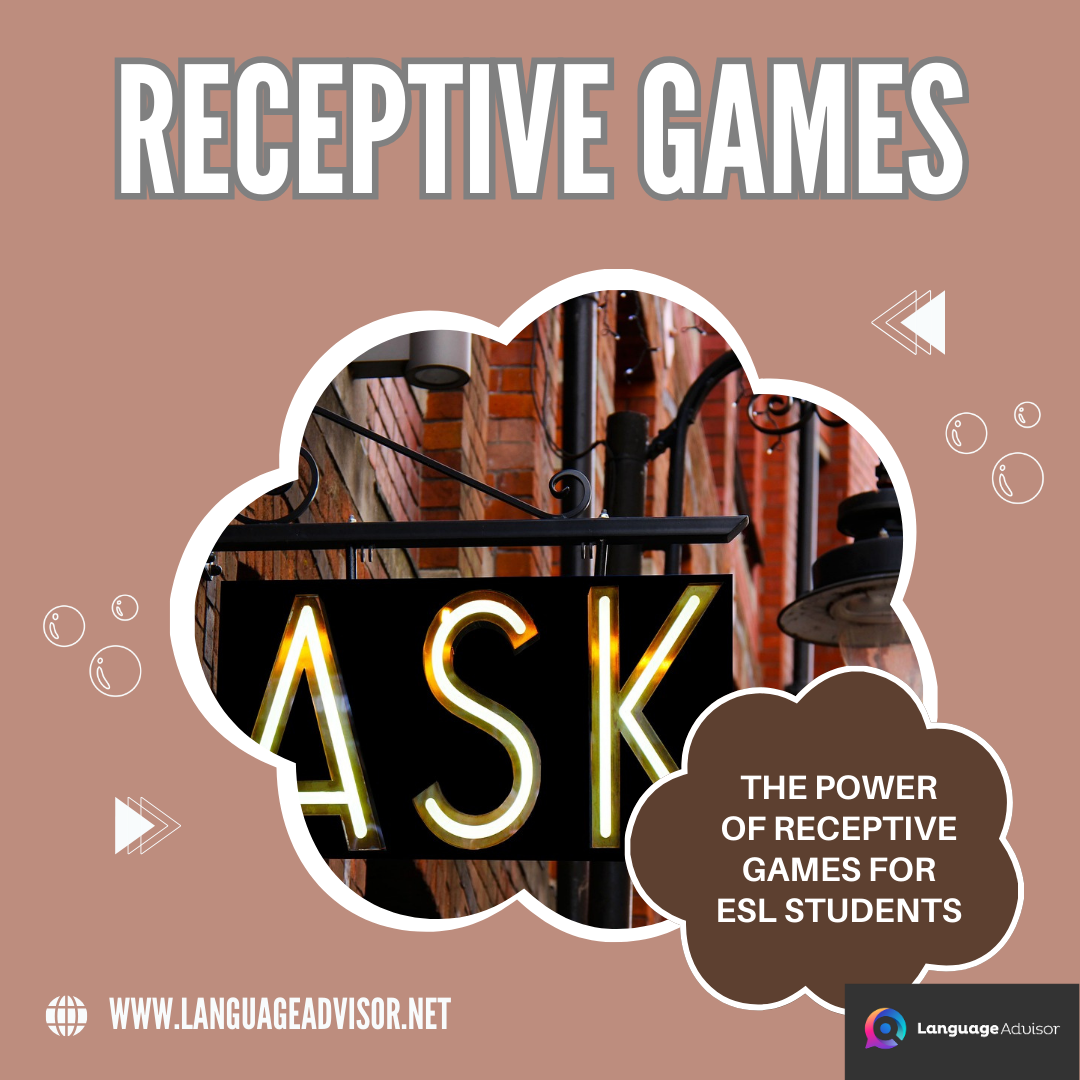Receptive Games. Enhancing Language Skills: The Power of Receptive Games for ESL Students
Receptive Games

Receptive language skills, such as listening and reading, are crucial components of language learning. Receptive games provide an engaging and effective way to develop these skills in ESL students. These games help learners understand and process language inputs, improving their comprehension and overall language proficiency. In this blog post, we will explore various receptive games that can be easily integrated into language lessons to make learning both fun and impactful.
Receptive Games

English Whispers
This is an adapted version of the classic game ‘Chinese Whispers‘. You can use this listening game to teach a variety of vocabulary, language structures, and topics. This game also helps to improve your students’ listening skills.

- Age/Level: Any
- Time: 20 minutes
- Players: Equal teams
- Preparation: A written conversation for each team
- Aim: To listen and repeat sentences
Procedure
Put the students into equal-sized teams and have each team sit down in a row. The students sat at the back of each row are given a different conversation. The students at the back whisper the first sentence of their conversation to the student in front of them.
That student then whispers the sentence to the next student, and so on down the line.
When the sentence reaches the person at the front, they stand up and write the sentence on the board.
If the sentence is incorrect, the sentence is whispered down the line again.
The game continues until one team has written all the sentences on the board correctly.
The student at the back of each row chooses when to whisper the next sentence. He or she could say each sentence quickly or wait until the sentence has been written on the board.
Try to make sure that the conversations are of equal length. Five to eight sentences are ideal.
For younger learners, you can play this listening game using individual words.

It’s not Musical Chairs
For this listening game, you will need some audio conversations, audio scripts, and some prepared questions about the conversations. The conversations can come from the course book you use in class. You may wish to use one long conversation or several short ones. This game is similar to musical chairs.

- Age/Level: Any
- Time: 20 minutes
- Players: Individual
- Preparation: Audio conversations, scripts and prepared questions
- Aim: To listen for the answer to a question
Procedure
Organize the chairs into a circle. There should be one less chair than there are students in the class.
To begin the game, ask the students a question. Then start playing the audio conversation. The students walk around the chairs listening to the conversation. When a student hears the answer to the question on the audio, they sit down. There may be one or several students who sit down.
At this point, pause the audio.
If it is just one student who sits down, ask them for the answer to the question. If it is a few students who sit down, ask them to whisper the answer to you individually.
If a student’s answer is correct, they remain seated.
Next, ask another question that can be answered in the next part of the audio conversation.
The students who have remained standing start walking around the chairs again until they hear the answer to your new question on the audio.
Carry on like this until there is one student left standing. That student is out of the game.
Remove a chair from the circle. Everyone stands up and the game continues until there are only two students competing for one chair to become the ultimate winner.

Sticky Fingers
This ESL listening game works really well with young learners. You play this game with three students at a time.

- Age/Level: Young learners
- Time: 15 minutes
- Players: 3 students each round
- Preparation: None
- Aim: To listen carefully for keywords
Procedure
Choose three students to play first. Outstretch your arm. Each student then grabs one of your fingers. Assign a special keyword. If you say the keyword, the students let go of your finger and run to the far wall. If on the way you tag a student, they are out. If a student lets go when you haven’t said the keyword, e.g. if the keyword is ‘take‘ and the student runs when you say ‘cake‘, they are out.
Repeat until only one student is left.
Then, start a new round with three more students.
When everyone has had a go, you can play again with the winners of each round. Keep playing until you find the ultimate champion.

Throw a Question
This is an enjoyable listening and speaking game. You can use this game for lower level students as practice or with higher level students as a review. For lower levels, you might want to cover the questions and answers before you play the game. For more advanced students, this game can be used as a review of what they have studied in past lessons.

- Age/Level: Any
- Time: 15 minutes
- Players: Individual
- Preparation: A ball
- Aim: To listen and answer questions
Procedure
Sit the students in a circle.
Tell the students that they will be practicing some questions and answers they have been studying in class.
Start by throwing the ball to a student. When the student catches the ball, ask him or her a question. The person who catches the ball must answer the question appropriately. Then, they throw the ball and ask another question to someone else, and so on.
This game helps students with their listening skills, because they are always in suspense not knowing who will go next. Therefore, they have to pay attention and listen to each question.

Incorporating receptive games into your ESL curriculum can significantly enhance students’ listening and reading skills. By making language input engaging and interactive, these games help students improve their comprehension and retain new information more effectively. Whether you’re focusing on vocabulary, grammar, or general language understanding, receptive games offer a dynamic and enjoyable approach to language learning. Try out these games in your next lesson and observe the positive impact on your students’ receptive language abilities.

Receptive Games. Also check out these class games












